
Emotions, Growth, Identity
Recently I watched The Life of Chuck… and I don’t even fully have words for how moved I am. It was profound, not in a flashy, intellectual, try-hard kind of way, but in the most simple, human, soul-level way. It wasn’t some blockbuster with special effects or gripping action. There’s no gory scenes or high-stakes thriller plot. It’s not trying to impress you. It’s just real. Quietly powerful. Deeply emotional. And brilliantly done.
What struck me first was how the story unfolded. It begins at the end, literally. Then moves backward through time: scene three, then two, then one. And it works. It actually makes you feel something different. By the time it ends on scene one, everything comes together in this slow, subtle, almost sacred way. You’re not told what to feel, you just feel it. And it’s beautiful.
What pulled me in was its simplicity. It’s not loud. It’s not grandiose. It’s a story about a man’s life but really it’s a story about all of our lives. About being alive and the moments we take for granted. The ordinary ones. The ones where nothing “important” is happening, but something extraordinary is available if we’re present enough to notice it. Like a spontaneous dance. A small yes to something you usually say no to. A shared silence. A smile. A sunset.
And what hit me even deeper was how the movie reminds us that the universe is always working in our favor, even when we can’t see it. It’s not random. There are clues, breadcrumbs, invitations everywhere. In this story, there are moments when something from Chuck’s past gets pulled into his present, like life is stitching together the timeline of his soul. Not to fix but just to illuminate it. To say, “Look, even that mattered.” These are the moments that give context to the chaos. That remind us something bigger is unfolding and always has been.
It reminded me of what we teach at Expanding You, that the point of all this, the real point, isn’t some perfect, productive version of life. It’s aliveness. Presence. Appreciation. The moment when you’re not in your head trying to fix or protect or perform but simply being. Connected. Awake. Free.
And yet, it’s so hard to stay there.
So often, my mind is busy judging, comparing, predicting, protecting… doing all the things it was trained to do. Trained by fear, by programming, by all the bullshit I inherited or absorbed along the way. It robs me, and steals the aliveness that is right there. Always right there. The dance. The joy. The breath. The wonder. The moment.
But sometimes, in rare beautiful flashes, we say yes. We take the risk. We override the fear. We open our heart instead of protecting it. We walk down a road we think is a dead end, and find something magical waiting there. That is where life happens, and those are the moments that touch our soul.
God, I’ve had those. In my travels, in unexpected conversations, in moments I almost said no to but didn’t. I’ve been down streets in foreign countries that looked like nothing… and then turned a corner into something I’ll never forget. Or opened up in a moment when I could’ve stayed shut down… and something true and beautiful unfolded. That spontaneous abandon, where you leap before your fears can stop you, those are the moments the soul never forgets.
It’s almost like the universe dares us: Will you trust life enough to keep going anyway?
When the mind finally does go quiet, and the heart opens, you see differently. You feel differently. You are different. And it’s so pure. Divine, really. This movie captured that so elegantly.
It also mapped something we talk about so often, the inner world we carry from childhood. The movie shows how our experiences build entire universes inside of us. Multiverses even. One line that really got me was: “I am wonderful, and I deserve to be wonderful.” That truth, that realization… it cracked me open.
What if that were the core of who we knew ourselves to be? What if that was what we built life on, not fear, not performance, not protection, but wonder and worthiness?
There’s a bittersweet ache I feel even as I write this. The longing to live from that place more fully. The sadness of all the times my conditioned mind blocks me. The heartbreak of how often fear still wins. The fear of being wrong, looking stupid or messing up. And how often that fear shrinks me, tightens me, dims me down. But underneath it all, there’s this quiet, strong longing, this yes inside me. I want to live with wonder, with aliveness, with joy. I want to embody it, share it, and awaken it in others.
And I want that for the people I work with too. For them to see the constructed identity for what it is, not bad, not wrong, just an outdated operating system filtering for protection, and to gently let it keep falling away. To discover that underneath it all, there is something wonderful, something wildly alive.
This movie reminded me again: The best moments in the universe are the simple ones. The real ones. And we’re already in them… if we’re willing to be here. And maybe even more so, if we’re willing to take the risk to go there, with spontaneous abandon and a heart wide open.
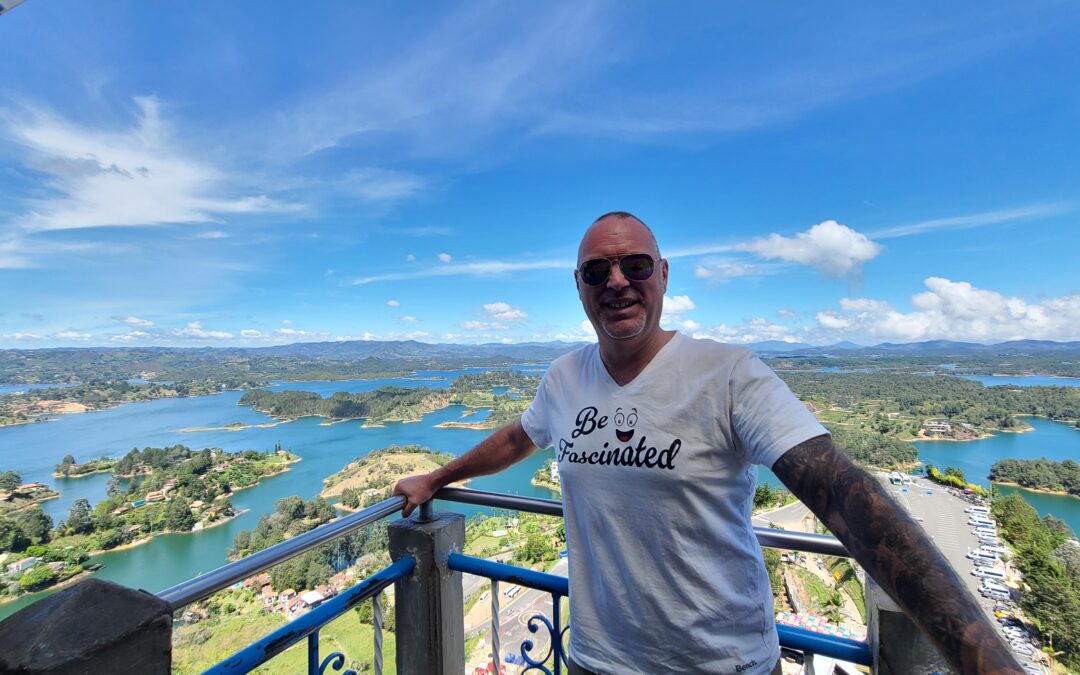
Emotions, Growth
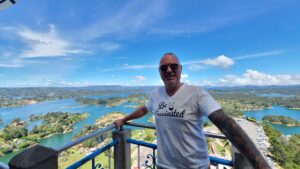
What cards, consciousness, and competition taught me about living from the Authentic Self
For ten years, I sat at the felt-covered tables of casinos and card rooms across North America, playing poker for a living. It was a strange career, equal parts thrilling, punishing, and psychologically revealing. I was in my 30s, and while I thought I was playing the game, I later realized the game was also playing me.
Now, after a decade immersed in personal transformation, nervous system healing, and spiritual realization, through the work that’s become Expanding You, I’ve come to see how deeply poker mirrors life. And more importantly, how most of us are still playing life like it’s poker: high-stakes, high-stress, trying to outmaneuver others so we can finally feel safe, seen, or significant.
But what if there’s another way to play? One that doesn’t require the bluff, the edge, or the internal war?
Let’s talk about that.
In the Hand or Out of the Hand: Blind Spots and Embodiment
One of the simplest but most powerful lessons poker taught me was this: everything feels different depending on whether you’re in the hand or watching the hand.
When you’re in the hand, meaning you’re one of the players involved in a big pot, making decisions with real money on the line, your nervous system is activated. There’s pressure, risk, and the unknown. You’re evaluating opponents, trying to read patterns, questioning your own reads, managing fear, and making bets that could cost you.
But if you’re out of the hand, just watching from the sidelines, it’s all obvious. You see who’s bluffing. You know who’s strong. You can tell who’s panicking. Your nervous system is calm, and your clarity is high.
And man, if that isn’t personal development in a nutshell.
Most of us are in the hand with our own pain, coping strategies, and unconscious stories. When we’re emotionally activated, caught in a fight with a partner, spiraling about money, or stuck in people-pleasing mode, we lose access to clarity. Our perception narrows. We don’t see clearly because our nervous system isn’t regulated.
Meanwhile, the people around us (if they’re regulated) can often see our patterns more clearly than we can. “You always shut down when things get vulnerable.” “You’re trying to control again.” “You’re scared and avoiding.”
But we resist. We’re defensive. We justify. Because we’re in the damn hand. And it feels real.
This is why embodiment and emotional regulation are at the heart of Expanding You’s Inner Balance work. You can’t think your way out of being “in the hand”. You have to learn how to be with your system, create internal space, and come back to your seat at the table, not to win the pot, but to reclaim your center, your empowerment.
Know the Rules. Then Break Them With Mastery.
I often say this about poker:
“First, you learn the rules. Then you learn how to break them, strategically.”
Same in life.
A beginner poker player learns how the hands rank. What beats what. When to fold. When to raise. A seasoned player doesn’t just follow the rules, they understand them so well that they can bend them to gain an edge. They know when to represent strength, when to trap weakness, when to bluff with nothing, and when to go all-in with air.
But here’s the twist: most people are playing life with that same mentality. They’ve learned the psychological “rules” of how to survive in their family system, school, or workplace. Be agreeable. Be strong. Be smart. Don’t show too much. Don’t be too emotional. Don’t lose.
Then, like a good poker player, they get strategic. They find the edges in others. They learn how to win arguments, negotiate power, and gain approval. They find ways to manipulate reality just enough to feel safe, loved, or significant.
But all of this comes from what I call your “Constructed Identity”, basically, the version of you that was shaped by past experiences, pain, and what you’ve been taught to believe about yourself. It’s protection mode…survival programming dressed up as “success.”
And just like poker, it’s all based on the illusion of control. You don’t control the cards. You don’t control the outcome. You only control how you show up to each hand, and who you become through it.
We’re taught from an early age, sometimes explicitly, sometimes subtly, that the world is a hostile place. “It’s a dog-eat-dog world out there.” “You’ve got to fend for yourself.” “Only the strong survive.”
It’s Darwin’s theory misapplied to human consciousness.
This thinking seeps into our relationships, our businesses, even our spiritual communities. We assume life is a one-winner game. That someone has to lose in order for us to win. That we must prove our worth, guard our vulnerabilities, and out-compete the next person or get left behind.
But that’s not how life actually works.
If you zoom out and look at nature, not just through the lens of predators and prey, but through ecosystems, you’ll see something radically different. Life thrives through interconnection. Bees don’t hoard all the pollen. Trees communicate through their roots to share nutrients. Wolves keep deer populations healthy. Everything is in relationship.
Life is not built on domination. It’s built on coherence.
When we believe we must dominate to survive, we’re still living from trauma. We’re in the Constructed Identity, operating from fear, protection, and separation.
But when we come into alignment with the deeper truth, that we are all part of one living, breathing system, we begin to see a different path.
“Humanity and the Earth are a team. They do not need to be divided.”
Winning by Making Others Fold: The Constructed Identity’s Favorite Game
Great poker players don’t just win with strong hands. They win by getting you to fold a better hand. That’s called skill. Or, in the business world, it’s called “strategy.” In marketing, it’s called “positioning.” In dating, “game.”
But if we’re honest, in life, it’s often called self-protection.
The Constructed Identity loves win-lose scenarios. It was built for them. As children, we learned to survive by being better than, less than, more liked, more quiet, more useful, whatever was required. The nervous system learned: If I win, I’m safe. If I lose, I’m not lovable. If I fold, I’m weak.
So what do we do? We spend adulthood trying to win every hand. We try to win at marriage. Win at spirituality. Win at healing. Win at Instagram.
Even in the personal development world, we’re bluffing with high-stakes language, acting like we’re “embodied” or “authentic” when we’re still terrified of being fully seen.
Lynn once asked me, “What’s a life lesson you’ve learned from poker?”
At first, I gave the usual response, pattern recognition, emotional regulation, risk tolerance. But then she pushed deeper. “How does it shape your view of the world?”
That’s when I saw it: poker is a zero-sum game. One person’s gain is another’s loss. There’s only one winner per hand.
That’s fine for a card game. But it’s a toxic operating system for relationships and life.
Too many people are still living with poker’s win-lose mentality. Find the weak spot. Exploit the gap. Beat the competition. Manipulate perception. Prove yourself. Build the edge.
We call this good business. Or good leadership. But it’s really just the Constructed Identity dressed up in a nice suit.
And this kind of leadership, let’s call it survival-based leadership, is everywhere. It’s competitive. Closed off. Opinionated. It leads by control, persuasion, or dominance. It’s not interested in understanding others; it’s interested in being right. In winning. And in being the smartest person in the room.
But authentic leadership is something else entirely.
Authentic leadership isn’t about being the best at knowing, it’s about being the best at listening. It doesn’t try to control people or outcomes. It invites curiosity. It holds multiple perspectives at once. It asks questions not to corner others, but to co-create something better.
This kind of leadership recognizes that truth isn’t a weapon, it’s a bridge. It builds trust. It allows the room to get smarter together. It shifts the room from competition to collaboration. From winning alone to rising together.
That’s a win-win-win game. That’s the kind of game the Authentic Self plays. (the truest expression of who you are, from your heart, before the fear, programming, and protective patterns took over.)
It doesn’t need to be the hero, or the one with the biggest stack of chips.
It simply wants everyone at the table to play a better game.
Play the Game Well, Even When You Don’t Win
(And why authentic risk is still worth it, every time.)
Here’s something every seasoned poker player knows:
You can play the hand perfectly, read the table, calculate the odds, stay emotionally grounded, make all the right moves, and still lose. The cards don’t always cooperate.
It’s the same in life.
Living in alignment with your Authentic Self, leading with love, being honest, choosing compassion, acting from clarity, doesn’t guarantee you’ll get the outcome you want. You might show up with total integrity, and still get misunderstood. You might offer your heart, and still get rejected. You might lead with wisdom, and still lose the hand.
But poker taught me something simple: you don’t measure your growth by how many hands you win. You measure it by how well you played, especially when the stakes were high.
And that’s where real risk-taking lives. Not in ego-driven bravado. Not in reckless leaps to prove your worth. But in sacred vulnerability, the kind of risk that says:
“I’m willing to be seen. I’m willing to tell the truth. I’m willing to love, even if I’m not met.”
That kind of risk isn’t loud or flashy. It won’t get you applause from the world.
But it will set you free.
The Authentic Self doesn’t avoid risk, it just chooses the kind that expands you, instead of the kind that contracts you. Risk becomes part of the path, not to manipulate an outcome, but to stay loyal to your heart.
In Expanding You, we often say:
“The outcome isn’t up to you. Your alignment is.”
So you risk showing up anyway. You risk being kind, even when others aren’t. You risk speaking up or asking the hard question, even if it makes you unpopular.
You risk loving first.
You risk letting go.
Because you know: the safest place to be is in full alignment with who you truly are.
That’s the deeper mastery.
When you stop playing life like a results-based game, and start playing it as an integrity-based path, something shifts. You show up with more peace. More openness. More grounded joy. You’re no longer gambling your self-worth on the next win.
You’re just here to play well, with a clean heart, a curious mind, and your whole being on the table.
What Game Are You Playing?
If you find yourself exhausted, always strategizing, chasing, comparing, proving… you’re probably still playing life like poker.
And that’s okay. We’ve all done it. We were taught that life is a tournament. That you need to get ahead. That someone else’s success means your loss. That vulnerability is a liability.
But there’s a deeper game available. It’s slower. Quieter. Richer. It doesn’t need to bluff. It doesn’t need to fold. It doesn’t even care what cards you’re holding, because it knows you are the prize, not the money or the recognition..
And in that game, everyone wins.
By Jeff Brown
Cofounder of Expanding You

Emotions, Growth
By Jeff Brown – co-founder of Expanding You
We were in round two of edits on the new Inner Balance trailer. Lynn and I had already given our feedback to the video editor, sent it off, and now here we were again, this time Leslie was here too, watching the new version together.
Leslie and Lynn had notes. They wanted more edits.
And while they spoke thoughtfully, my system tensed up. I felt a flicker of annoyance. Then impatience. My mind whispered: “Didn’t we already go over this? We asked the editors to make that change. It’s fine. It’s good enough. Let’s move on.”
Recognizing old emotional programming in everyday reactions
In the past, I might’ve let those feelings drive the next move. I might have tried to steer the conversation toward settling. But that’s not what happened this time.
This time, I caught it.
That flicker of frustration? It was the signal that told me to pay attention and notice I was out of balance. Not because of the situation, but because of what was stirring inside me.
So I turned my attention inward. What’s really going on here?
First, I took a moment and gave myself permission to feel my feelings. In the past, I would have skipped over my feelings entirely and gone right to getting the job done. Instead, I followed the thread of my annoyance into my past, and it took me right back to childhood. My dad’s voice echoed in my head, impatient, always rushing, never fussed about details. “It’s fine. Just leave it. Doesn’t matter.” Saving time mattered more than getting it right.
And layered on top of that? My mom’s quiet concern. “Don’t ask again. It’s rude. You’re being a burden.”
Ah. There it was. My dad’s belief that “saving time matters more than getting it right” conflicts with my mom’s belief of “don’t be a burden”. I was embodying the beliefs of my parents and tying myself up in knots.
How old emotional programming shapes our present behavior
At Expanding You, we teach that all behaviour is internally motivated. Knowing this, I was able to turn inward and recognize my struggle was old programming and emotional wounds running inside of me, it wasn’t about the trailer video edits.
And now I had a choice: stay in it, or shift out. So I named it out loud to Lynn and Leslie.
“I’m noticing I’m feeling frustrated, and I’ve got some old programming showing up here. I can hear my dad’s voice, that urge to just wrap it up. And I can feel that pressure from my mom’s message that we shouldn’t ask for more.”
Bringing it into the light took the charge out of it.
From resistance to authentic alignment
Then I anchored into the facts:
- This trailer is going on our website and into our marketing. I want it to be the best it can be.
- We’re paying our editors by the hour. So what if there are more edits?
- We weren’t as clear as we could’ve been the first time. That happens. Let’s just fix it now.
From there, my system started to settle. I moved from resistance to receptivity. From internal conflict to clarity. From annoyance to something softer, collaboration. These are the skills we introduce in the Inner Balance program.
By naming the beliefs and programming that were running, and choosing truth over the old narrative, I shifted in real time. This shift is a healing moment where I consciously break free from an old, unhealthy unconscious pattern that was programmed many years ago. That’s the power of the work we do at Expanding You.
Was I suddenly elated? No. And that’s important to note. Even after the mental shift, the emotion takes a moment to catch up. I wasn’t in a full state of joy, but I was out of resistance. My heart, I’d say, was at a 3 out of 5. Open. Connected. Not ecstatic but present, grounded.
I could feel myself land back into my body. Not just understanding the shift intellectually, but feeling it. That’s the move from my constructed identity, that version of me that was unconsciously rooted in protection and fear, to embracing my courageous, authentic self, the version of me grounded in love and presence. What I could have easily labelled as a micro-moment of regulation was in fact a healing experience.
This is what transformational work looks like. Leaning into everyday moments, noticing the layers of beliefs and programming informing my behaviour and choosing differently.
Tracking a real-time inner transformation
In Expanding You, we track this shift using the lineage of behavior:
Programming → Beliefs → Thoughts → Feelings → Actions → Experience
In that moment, I walked the chain backward. From the experience (impatience during edits), I tracked it to the action I was about to take (push to move on), the feeling behind it (irritation), the thoughts fueling that (this is fine, this is a waste), the beliefs under that (asking for more is rude, perfect isn’t worth the time), and finally the programming it all stemmed from.
And by seeing it, by owning it, I got to choose something different.
The deeper truth?
It’s not too much to ask for what you want. It’s not wrong to revisit something to make it better. And it’s definitely not more noble to settle for “good enough” when your vision is calling for more.
So we created and sent a list of the new edit suggestions. Not from fear or overthinking, but from presence. When I showed up this way, I felt connected, confident, and my self-esteem increased.
This is what it looks like to apply the work. Not just in the big moments of life, but in the sometimes subtle, everyday ones where our nervous systems get activated and our old programs or emotional wounds try to steer the ship.
This moment wasn’t a breakdown. It was an invitation for a breakthrough. And I said yes.
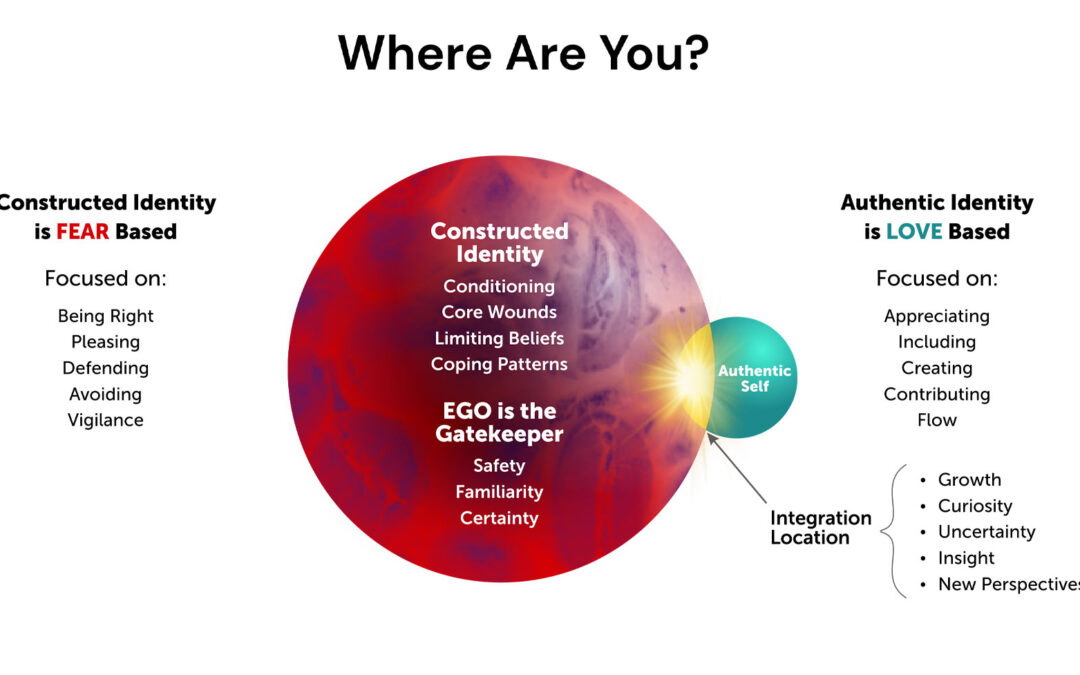
Growth
This blog is based on a conversation with Lynn Sumida and Jeff Brown, founders of Expanding You.
There’s a fun little team building challenge that you may be familiar with; using only scotch tape and dry spaghetti noodles, build the tallest tower possible that can support a single marshmallow at its top. Called the Marshmallow Challenge, this test was used in a study by designer Tom Wujec that compared the performance of different groups in this kind of challenge.
Teams, on average, were able to suspend the marshmallow about 20 inches in the air, but there were a couple surprises. Notably, lawyers and business graduate students performed well below average, while CEOs scored just barely above it. Coming in several steps above the CEOs, however, were kindergarteners.
How is it that decades of education and experience did not allow these professionals to surpass children in this challenge? One common theory is that, while the adults would begin by deliberating on plans and divvying roles between one another, the kids would simply get hands on noodles and go to town.
A kindergartner with an idea doesn’t stop to ask if everyone agrees and thinks it’ll work – they just try and see! If another kid saw that wasn’t working, they had very few reservations about grabbing extra materials and testing an idea of their own. Where adults engage in a political and social dance of identifying leaders, being polite, and trying to appear smart or helpful, children simply play.
The good news is that the creative, playful approach of our childhood is still accessible to us as adults – it’s just obscured by a lifetime of conditioning. This conditioning forms what Exanding You calls the Constructed Identity (familiar to those who have read how our relationship with identity changes) and it has a number of defining characteristics:
The EGO seeks to preserve our Constructed Identity and maintain a sense of safety, familiarity, and certainty. Its purpose is to protect us from perceived threats to our well-being, often at the expense of growth and change.
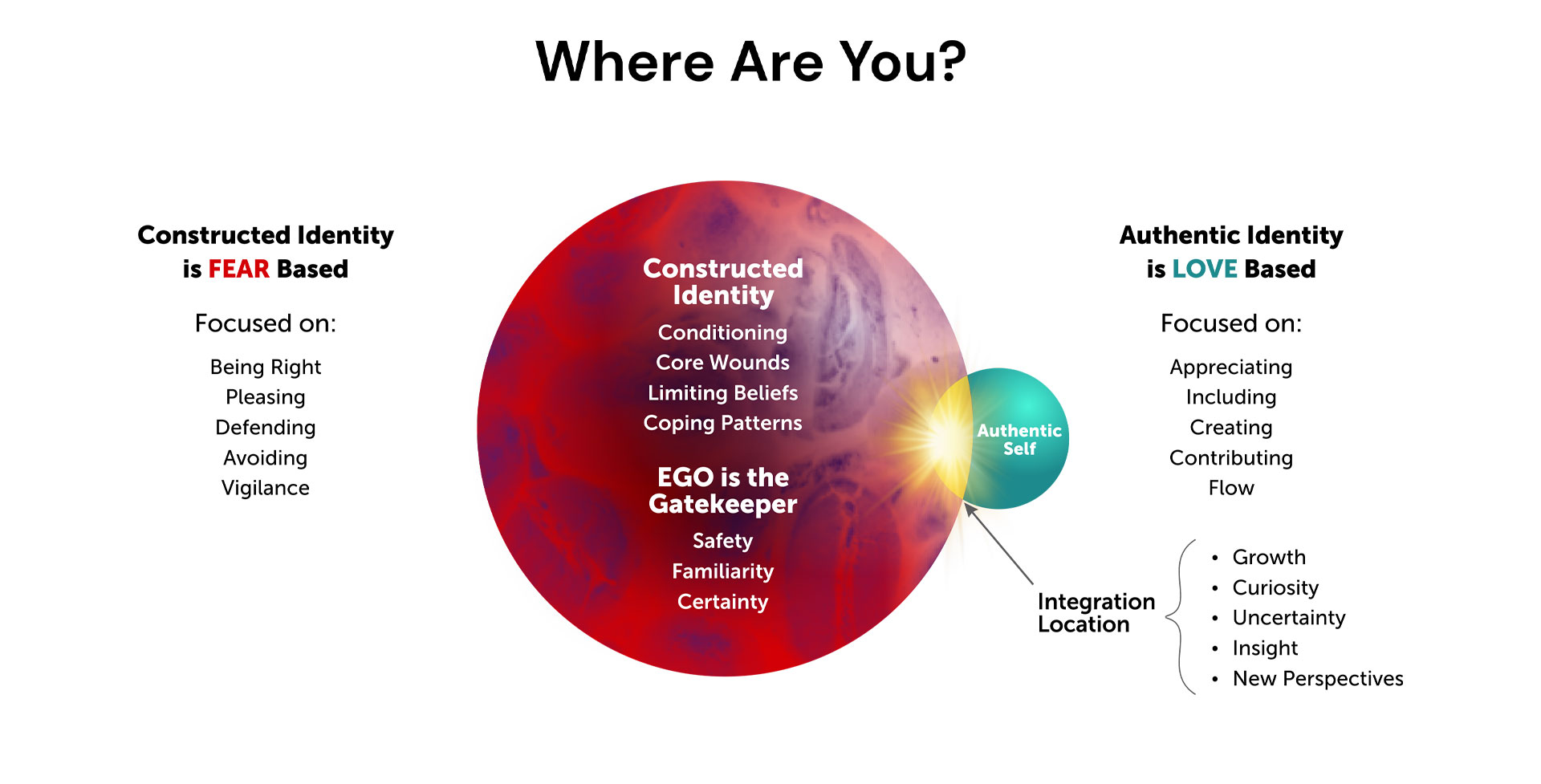
To see how this fits with your own experience, imagine yourself starting the Marshmallow Challenge with a team of strangers – what would you do? Would you offer a suggestion, or wait for someone else to speak first? If people rejected your idea, how would you feel?
If you notice thoughts such as “oh, I don’t want to be rude,” “what do I know,” or “this idea better work,” you might be engaging through a Constructed Identity. These thoughts are guided by fear, such as fear of seeming aggressive, arrogant, or unintelligent. The EGO uses this fear to keep us in familiar, tried-and-true patterns rather than engaging in a way that risks our sense of safety.
The Constructed Identity is formed early on and developed over time. Moments of stress or of praise subtly (or not so subtly) inform our young, growing brains of the behaviors that will help us avoid discomfort and gain recognition. Beliefs are formed and then reinforced by similar experiences throughout our lifetime, creating patterns in our relationships with self, others, money, and more.
Constructed patterns bring varied results – you might have learned to value work ethic, receiving raises and accolades in your professional life. Or you might feel like you keep dating the same person over and over, each time ending the same as the last. As we pay more and more attention to the thoughts and beliefs embedded in these repeated experiences, we give focus to the constructed identity, taking it away from the adventurous, trusting, authentic self that characterized our childhood.
It is this over-attentiveness that makes our beliefs seem “real” and keeps us from challenging them. The Expanding You programs shine a light on these beliefs and how they are operating in your life. Let’s imagine that, at some point in elementary school, you excitedly jumped up from your desk when the lunch bell rang, eager to dine and play with your friends.
This was met with a scolding from your teacher who saw this as disruptive and rude, and immediately your EGO takes note that being overly expressive risks your social safety. You start to become more vigilant in how you display your emotions, seeking to avoid the discomfort of potentially having your feelings responded to negatively.
Time and again you restrain yourself, rarely (if ever) challenging the constructed identity’s idea of how to behave. As you get older, it takes up a larger and larger part of your attention and informs more and more of your behavior.
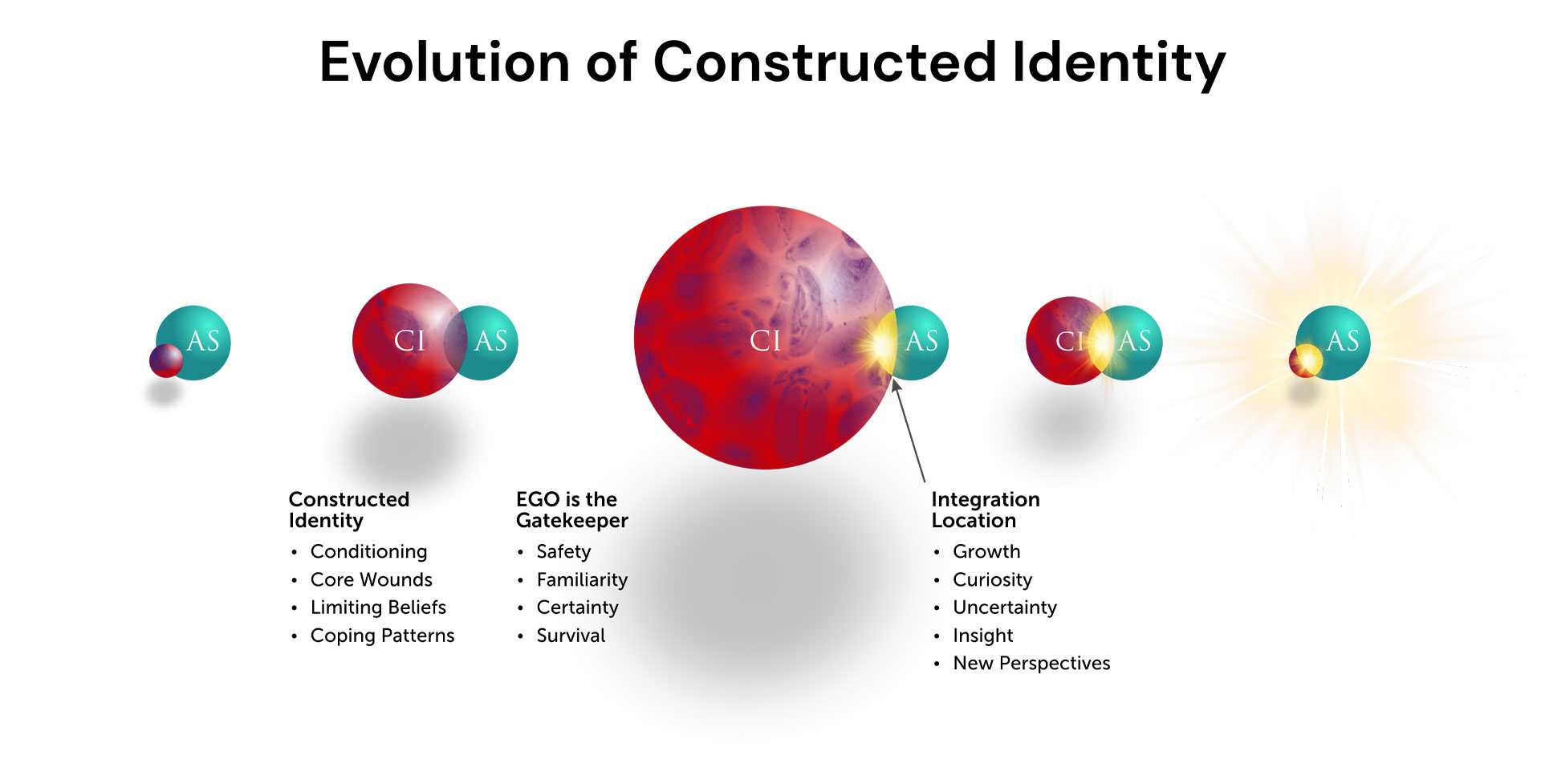
This mindset is depicted at the center of Lynn Sumida and Jeff Brown’s model for how their concept of the Constructed Identity changes over time. Depicted above, the center is where many of us spend the most of our time. In this space we worry about what we “should” be, do, or say. We fret about things that are outside of our control, such as peoples’ reactions to us or events that have already happened or have yet to happen.
The good news is that we can move away from fear and shift our attention back to the loving, Authentic Self. First, recognize that the Constructed Identity doesn’t actually become more true or real as our attention to it grows; like a tiny pimple on a beautiful face, it fights for our attention thinking that, if we obsess over it, we can protect ourselves from embarrassment.
Rather than clinging to an old belief that “pimples are gross” or “everyone will notice,” we can invite new perspectives to lead us, like “my body is a whole ecosystem of its own” or “people like me for so much more than my face.” We let go of our certainty that “people will see it” and engage curiously with uncertainty, open to new experiences of ourselves and others.
Challenging the paper tiger of the Constructed Identity in this way demonstrates to ourselves that the beliefs and experiences recorded within are only as powerful as the attention we give them. In fact, having held constructed beliefs in the past allows us to be even more powerful in the present. Notice the difference between the left- and rightmost stages above, where the identities overlap; the glowing spot on the right is the Location of Integration.
This is where we have learned to accept the Constructed Identity for its contributions to our growth and security. Here we notice its influence non-judgmentally and may choose to engage with it curiously. With this awareness we have new respect for our choices and our experiences.
This is where, you may be happy to hear, we adults can surpass 5 and 6 year-olds. While they may step into the Authentic Self more readily, it is without the wisdom and appreciation that comes with integration.
So practice checking in with yourself – where are you? Are you guided by fear, or love? Our Feeling Wheel is a powerful tool for this, if you get stuck.
If your beliefs feel limiting, what new perspectives might you focus on instead? Soon enough, with practice, you might be able to challenge some kindergarteners to the Marshmallow challenge… and win!
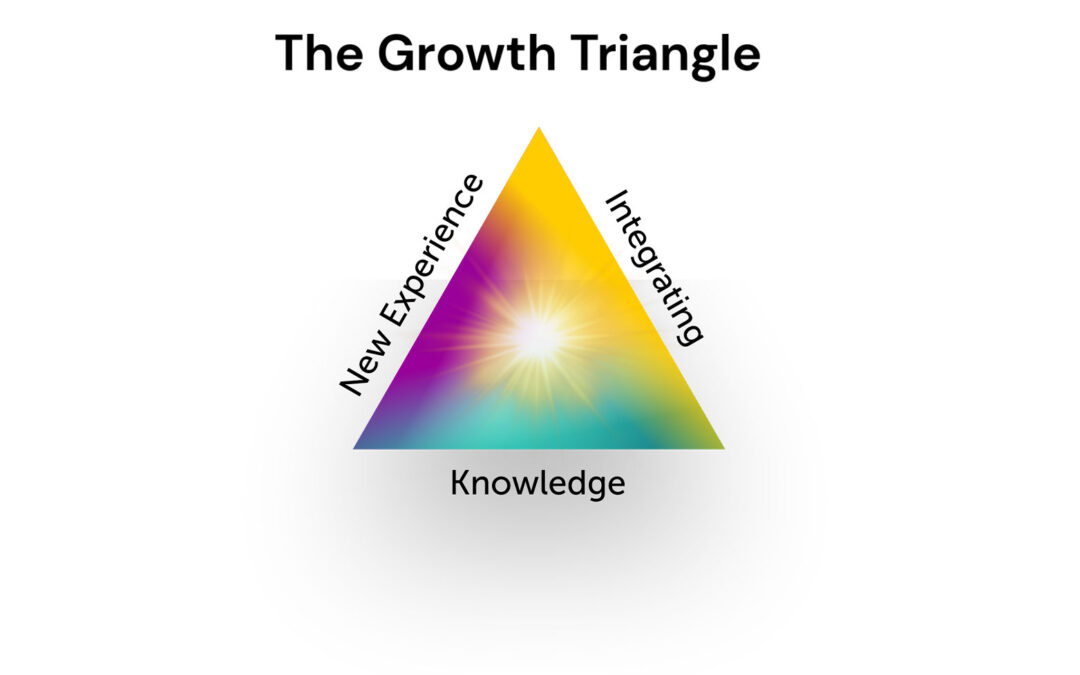
Growth
This blog is based on a conversation with Lynn Sumida and Jeff Brown, founders of Expanding You.
Before diving into the ingredients we recommend for an upward, transformational path, I want you to recall the best meal you’ve ever had. Picture it there in front of you and remember what it felt like to take a bite – or perhaps scoop – of that delicious meal. Think about the flavors and textures it has, and the satisfied feeling of leaning back as the last morsel turns to bits in your mouth.
Hopefully your mouth is watering now, but don’t run off for a snack just yet – hang on to that memory and I promise to make the most of it in just a few paragraphs.
Firstly, since you are here and reading this, it is likely that you desire some kind of transformation in your life. Some event or events have occurred and inspired a desire for growth within you. I would like you to consider what it was that started you on this path. Was it a high point? A feeling of “wow, I need to figure out how to get more of that!” Or was it a low point – a sudden realization that something has to change?
Chances are, it’s a mix of both, but regardless which type of experience has brought you here, Expanding You is glad to have you with us and their team wants to give you tools to help steer you towards that “wow” feeling. The first tool, in fact, is one you are already familiar with – you just may not have realized it yet.
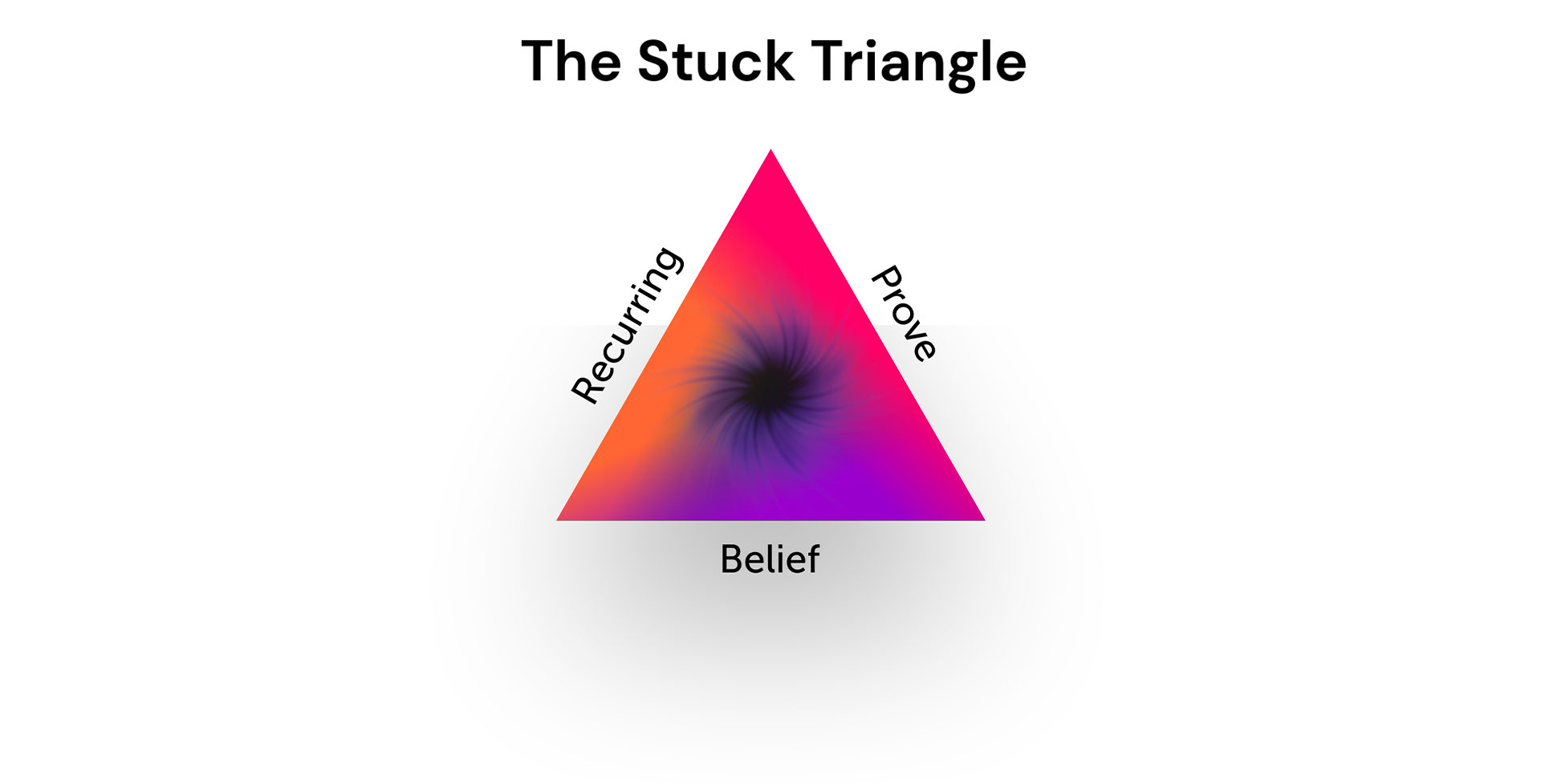
This tool is called the Stuck Triangle, and we have all experienced its effects. Those of you who had a recent low point might be feeling it acutely. Have you ever felt that, no matter what you do, you always get the same results? Do you feel your life is full of the same patterns or habits? Does it seem like there must be more, but you just don’t know where or how to find it? This is the stuff the Stuck Triangle is made of.
It may even be that the patterns we find ourselves stuck in are quite comfortable; being “stuck” in this sense is not a painful or unpleasant experience so much as an incomplete one. We get the sense that we have stagnated while there is more left for us to uncover, know, and feel. So why did we stop growing?
Well, the first ingredient of the stuck triangle is a belief – one that was likely formed very early in your life. Perhaps the belief was formed after a math test, when your teacher handed you back a paper that said “study harder” in glaring red ink. Or maybe the belief was formed in your childhood bedroom, while you sheepishly scooted toys under the bed because mom told you she can’t stand it when company comes over and sees your mess.
Whatever it was or whenever it happened, you likely formed an underlying belief about yourself or the world that unwittingly locked in. At that moment, the idea that “I’m not smart” or “I have to maintain appearances to be loved” entered into your programming.
It’s actually a sensible thing to do – our minds and nervous system try to protect us by recognizing danger (whether physical or emotional, real or imagined) and adapting our behaviour to avoid that danger. But many of us have since discovered that such adaptations often hurt as much as they help, and they obscure the person that we really want to be.
Those learned behaviours, in fact, are the next ingredient of being stuck; after a belief has been formed, we might spend years picking easy classes, avoiding homework, or anxiously tidying up, desperately avoiding the perceived danger in challenging our beliefs.
This creates recurring experiences which turn the belief into a habit – by avoiding learning, we perpetuate the idea that we are not smart. By seeking out and treasuring each comment of, “you keep such a lovely home!” we reinforce the belief that we must “do” to earn love. This creates proof in our minds that the belief is real and the cycle of being stuck continues.
Now, if this only happened with beliefs that were aligned with our innermost selves, we’d be all set! But as I’m sure you’ve experienced, some beliefs result in stress, frustration, and various other feelings of incongruence between what we think we should be or do and what we truly want and value.
At Expanding You transformation is viewed as the process of becoming more congruent and whole, and our next tool shows us the way towards it:
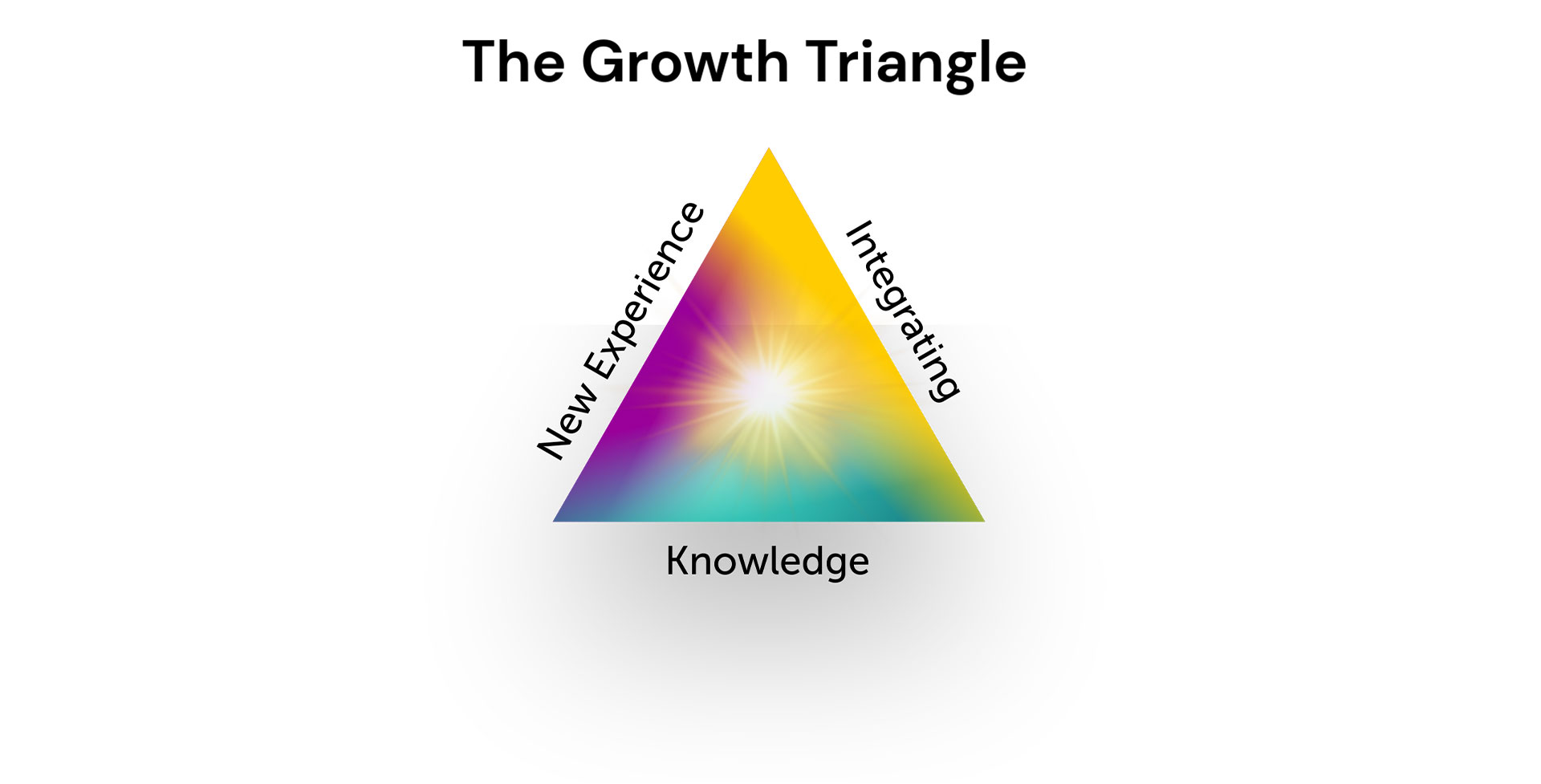
Growth is built upon the conscious integration of new experiences and knowledge. Moving upwards towards transformation means acquiring new ideas, perspectives, or tools we can use to interact with the world. It means seeking out genuinely new experiences to replace the recurring ones we were stuck in before, and leaning into tools and experiences until they become intuitive to your daily life.
A word of warning – in Expanding You’s experience, focusing on acquiring new knowledge and creating new experiences doesn’t immediately make us unstuck. You can still get stuck by creating a new pattern of seeking, but not applying, new knowledge. Some of us start finding tools for mindfulness, communication, or emotional intelligence and end up creating a great big box of pristine, hardly-used tools.
Think back for a moment to that delicious meal we talked about at the start – that wonderful flavor is our litmus test for a “new experience.” Getting stuck in knowledge is like reading the recipe for that delightful dish over and over, buying the special spoon, mixer, or slicer that we might not even know how to use, and then imagining what the meal is going to taste like without ever preparing the dish.
As an example of this, I currently have in my kitchen a ravioli maker that I have not once used. And, in the kitchen of my mind, I hold at least three recipes for different ravioli dishes. Next to those, my mind has a few ideas for assertive conversation with my roommates about dirty dishes.
Those also remain untouched. This causes our kitchens and relationships to become cluttered with unused utensils and unspoken thoughts. We may fantasize about, but never practice or experience, the meal or relationship we desire.
Lynn Sumida highlights that sometimes new knowledge is simply too advanced for us when we find it. We might think we understand a tool intellectually, but find that practicing it doesn’t give us the new experience we were expecting.
Let’s say I came across a beautiful quote:
“Truth is always what IS happening, not your story about
what SHOULD be happening.”
~ Byron Katie
Perhaps I decided to apply this wisdom to my situation around the dirty dishes; I tell myself “the truth isn’t that my roommates SHOULD wash their dishes, it’s that they don’t want to wash the dishes.” I then try to ignore the dishes in the sink, congratulating myself on my newfound enlightenment as the resentment I have with my housemates continues to simmer underneath.
Using knowledge in this incomplete way – where a problem isn’t solved so much as glazed over – is often due to misunderstanding how that knowledge is supposed to be used. This is why it is so important to sit with new knowledge, looking within ourselves until we feel a genuine shift in our understanding of the knowledge before applying it.
While we are absorbing new knowledge and creating new relationships with ourselves and the world around us, it is important that we remain patient with the process of integration. It takes time to practice putting knowledge into action, to create new behaviour, reflect on our experience, and to process those results into wisdom.
A good marker that you’ve reached an integrated state is when you can share your journey with others. Describe how your experience has changed you and what brought you to your new insight; if the change feels clear, you’ve probably given growth the time it needs to be digested.
But the time to integrate doesn’t have to feel like waiting – imagine it as building and anticipating. Remember that mouth-watering experience of your favorite meal? That’s the type of thinking that makes integration feel easy to work towards.
Every time you run into a hard conversation, a stressful moment, or maybe just get a little bored, picture the delicious spread awaiting you. Suddenly you’re not just buying milk, peeling potatoes, or boiling water – you’re making the world’s best baked potato soup!
Now that I’ve worked up your appetite, I’ll let you get to cooking. But as you do, try to practice the knowledge you’ve gained here. Think about where you may be stuck in old beliefs. Pick one, or maybe two, and use the guidance from Expanding You’s Stuck Triangle to get clarity on what isn’t working.
Then the Growth Triangle will help you move forward. What new thought, idea, belief would help you? Remind yourself of your goal: the wonderful flavors that await you when the cooking is done.
And don’t forget to give yourself time before, during, and after to process, and to keep your senses peeled for a truly new experience within yourself – you’ll know you’re on the right track if life starts to smell more and more delicious.










